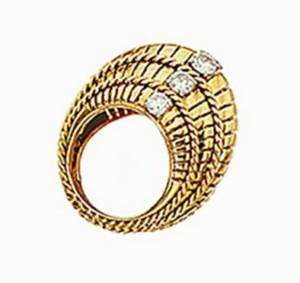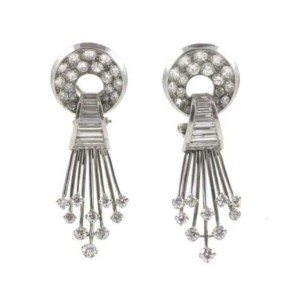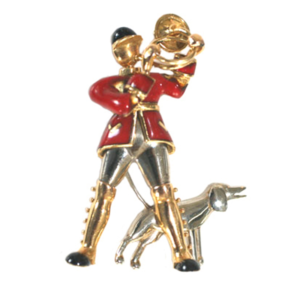Mellerio dits Meller, the oldest jewelry house in France, amazingly still remains active and in the hands of the founding family. Originally from the Lombardy region of Italy, the family relocated to France as early as 1515. In 1613, an assassination plot to kill King Louis XIII was uncovered by a chimney sweep also from Lombardy. As a reward, a royal decree was put forth allowing the inhabitants of three villages in Lombardy to ply their trade in Paris without the administrative restrictions generally applied. The Mellerio family was one of many that benefited from this decree, and worked as goldsmiths in Paris.
Jean-Baptiste Mellerio worked selling trinkets and boxes outside Versailles around 1777, and attracted the attention of Marie-Antoinette, who bought them to give as gifts to her friends. Marie-Antoinette’s patronage helped Mellerio to quickly became a jewelry supplier for many influential Nobles. This new patronage allowed him to open a store in 1796 at 20 rue Vivienne, and entitled “Mellerio dits Meller the “couronne de fer”, meaning the Iron Crown. Within four years, the business moved again to the rue du Coq St, Honoré, opposite the Tuileries Palace and close to the popular Verdôme area of Paris. After the revolution, Mellerio enjoyed the patronage of Empress Joséphine and Napoleon’s sisters, Pauline Borghèse and Caroline Murat.
Even under the July Monarchy, Mellerio dits Meller fared quite well, having been a favorite of the Duc d’Orleans before his ascension to the throne, as well as the appointed jeweler to the Duchess of Orléans since 1815. After their ascension to the throne, Mellerio continued to provide jewelry to Queen Marie-Amélie and King Louis-Phillipe as well as their court. In 1832, the Mellerio family acquired the property of what is 5 Rue de la Paix in Paris -now 9 Rue de la Paix- where they remain to this day.
During the unstable times of the revolution in 1849, the house established a presence inMadrid, Spain, using the name Mellerio-Hermanos. There they came under the patronage of Queen Isabella II, who purchased a scallop-shell tiara for the marriage of her daughter, the Infanta Isabela, the Princess of Asturias. This piece, Mellerio’s centerpiece at the 1867 Paris Exhibition, currently remains in the hands of the Spanish royal family, along with several other pieces by Mellerio, including the Spanish Floral Tiara worn by Queen Sofia. Other royal patrons of the Mellerio family include Queen Emma of the Dutch royal family and King Victor Emmanuel II of Italy, who purchased a diamond tiara for the marriage of his son to Margherita of Savoy.
While in Madrid, Mellerio gave a tiara of laurel leaves set with pearls to the Countess Montijo, who became Empress Eugènie, wife of Emperor Napoleon III, the last monarch of France. They continued to provide jewelry to the royal couple and were tasked with creating a fan using over 1,000 diamonds from the French Crown Jewels. This fan, along with the other creations using the Crown Jewels, was displayed at the Paris 1855 Exposition Universelle as the focal point of the Exposition.
In addition to the 1855 Exposition Universelle, in the latter half of the 19th century, Mellerio was involved in the 1862 Exposition Universelle in London and the 1867 World Exhibition in Paris. Following their involvement in the 1878 Paris World Exposition, Mellerio expanded again to include branches in Biarritz in the south of France, and Baden-Baden, a famed spa resort in Germany.
For the 1900 Paris Exposition Universelle, Joseph and Jean-François Mellerio produced several pieces using the motif of the peacock. They were notable for their mastery of Art Nouveau. Along with many of the popular jewelry houses in France, Mellerio was quick to respond to trends in tastes and cater their pieces specifically to their patrons.
In 1925, Mellerio entered in the Exposition des Arts Decoratifs, and in the 1931 Exposition colonial where they were awarded the grand prize. In 1935, following a decades-long renovation of their space begun in 1919, Mellerio hosted a retrospective exhibition of their pieces. Mellerio also entered the 1939 World Fair in New York, one of their few ventures into America.
Currently, Mellerio is responsible for the production of the Coupe des Mousquetaires for the French Open, and ceremonial swords for the Academie Française. Mellerio responded well to the transition into the modern world, adapting by creating boutique jewelry at a much lower price. They were one of the first jewelry houses to make a distinction between high jewelry and consumer jewelry, creating a distinction between the two as early as 1855. While, for the most part, their designs did not break any new ground, there jewelry was and is very well executed and wearable.
The House of Mellerio is currently run by François and Olivier Mellerio, the 14th generation of the family and, with the support of the Comité Colbert has expanded to Luxembourg and various department stores within Japan.
Showing all 3 results
-
$500,010,000.00




